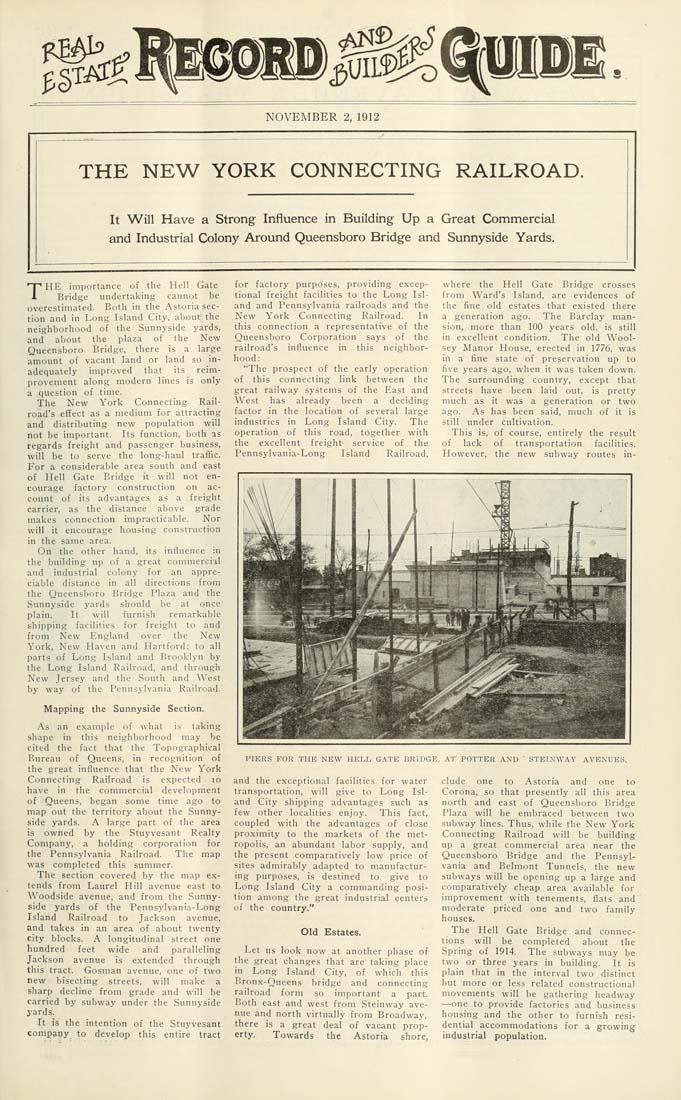Columbia University Libraries Digital Collections: The Real Estate Record
Use your browser's Print function to print these pages.
Real estate record and builders' guide: [v. 90, no. 2329]: November 2, 1912

Text version:
Please note: this text may be incomplete. For more information about this OCR, view About OCR text.
mm NOVEMBER 2, 1912 THE NEW YORK CONNECTING RAILROAD. It Will Have a Strong Influence in Building Up a Great Commercial and Industrial Colony Around Queensboro Bridge and Sunnyside Yards. THE importance of the Hell Gate Bridge undertaking cannot be overestimated. Both in the Astoria sec¬ tion and in Long Island City, about the neighborhood of the Sunnyside yards, and about the plaza of the New Queensboro Bridge, there is a large amount of vacant land or land so in¬ adequately improved that its reim- provement along modern lines is only a question of time. The New York Connecting Rail¬ road's effect as a medium for attracting and distributing new population will not be important. Its function, both as regards freight and passenger business, will be to serve the long-haul traffic. For a considerable area south and east of Hell Gate Bridge it will not en¬ courage factory construction on ac¬ count of its advantages as a freight carrier, as the distance above grade makes connection impracticable. Nor will it encourage housing construction in the same area. On the other hand, its influence in the building up of a great commercial and industrial colony for an appre¬ ciable distance in all directions from the Queensboro Bridge Plaza and the Sunnyside yards should be at once plain. It will furnish remarkable shipping facilities for freight to and from New England over the New York, New Haven and Hartford; to all parts of Long Island and Brooklyn by the Long Island Railroad, and through New Jersey and the South and West by way of the Pennsylvania Railroad. Mapping the Sunnyside Section. As an example of what is taking shape in this neighborhood may be cited the fact that the Topographical Bureau of Queens, in recognition of the great influence that the New York Connecting Railroad is expected lo have in the commercial development of Queens, began some time ago to map out the territory about the Sunny¬ side yards. A large part of the area is owned by the Stuyvesant Realty Company, a holding corporation for the Pennsylvania Railroad. The map was completed this summer. The section covered by the map ex¬ tends from Laurel Hill avenue east to Woodside avenue, and from the Sunny¬ side yards of the Pennsylvania-Long Island Railroad to Jackson avenue, and takes in an area of about twenty city blocks. A longitudinal street one hundred feet wide and paralleling Jackson avenue is extended through this tract. Gosman avenue, one of two new bisecting streets, will make a sharp decline from grade and will be carried by subway under the Sunnyside yards. It is the intention of the Stuyvesant company to develop this entire tract for factory purposes, providing excep¬ tional freight facilities to the Long Isl¬ and and Pennsylvania railroads and the New York Connecting Railroad. In this connection a representative of the Queensboro Corporation says of the railroad's influence in this neighbor¬ hood: "The prospect of the early operation of this connecting link between the great railway systems of the East and West has already been a deciding factor in the location of several large industries in Long Island City. The operation of this road, together with the excellent freight service of the Pennsylvania-Long Island Railroad, where the Hell Gate Bridge crosses from Ward's Island, are evidences of the fine old estates that existed there a generation ago. The Barclay man¬ sion, more than 100 years old, is still in excellent condition. The old Wool¬ sey Manor House, erected in 1776, was in a fine state of preservation up to five years ago, when it was taken down. The surrounding country, except that streets have been laid out, is pretty much as it was a generation or two ago. As has been said, much of it is still under cultivation. This is, of course, entirely the result of lack of transportation facilities. However, the new subway routes in- PIERS FOR THE NE'W HELL GATE BRIDGE, AT POTTER AND ' STEIN-WAY AVE.XUES, and the exceptional facilities for water transportation, will give to Long Isl¬ and City shipping advantages such as few other localities enjoy. This fact, coupled with the advantages of close proximity to the markets of the met¬ ropolis, an abundant labor supply, and the present comparatively low price of sites admirably adapted to manufactur¬ ing purposes, is destined to give to Long Island City a commanding posi¬ tion among the great industrial centers of the country." Old Estates. Let us look now at another phase of the great changes that are taking place in Long Island City, of which this Bronx-Queens bridge and connecting railroad form so important a part. Both east and west from Steinway ave¬ nue and north virtually from Broadway, there is a great deal of vacant prop¬ erty. Towards the Astoria shore, elude one to Astoria and one to Corona, so that presently all this area north and east of Queensboro Bridge Plaza will be embraced between two subway lines. Thus, while the New York Connecting Railroad will be building up a great commercial area near the Queensboro Bridge and the Pennsyl¬ vania and Belmont Tunnels, the new subways will be opening up a large and comparatively cheap area available for improvement with tenements, flats and moderate priced one and two family houses. The Hell Gate Bridge and connec¬ tions will be completed about the Spring of 1914. The subways may be two or three years in building. It is plain that in the interval two distinct but more or less related constructional movements will be gathering headway —one to provide factories and business housing and the other to furnish resi¬ dential accommodations for a growing industrial population.